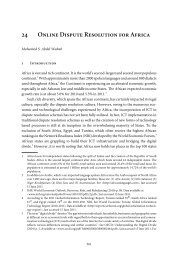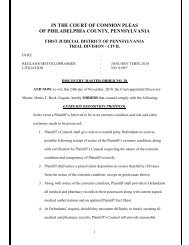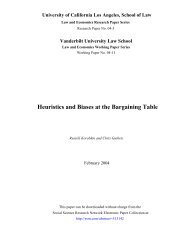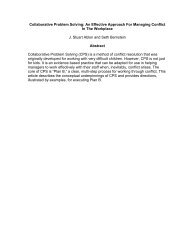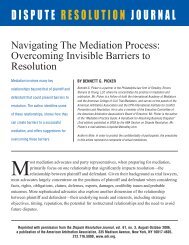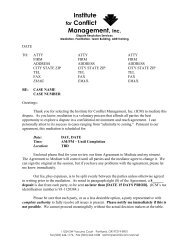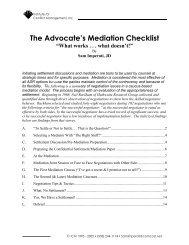17 e-Mediation - Mediate.com
17 e-Mediation - Mediate.com
17 e-Mediation - Mediate.com
Create successful ePaper yourself
Turn your PDF publications into a flip-book with our unique Google optimized e-Paper software.
<strong>17</strong> e-<strong>Mediation</strong><br />
– Face-to-face mediation is transparent regarding the question of who is speaking with<br />
whom, at any given moment. As different forum dynamics play out, with all parties<br />
convened around a table, parties switching in and out of a mediation room as the<br />
mediator caucuses with each of them separately, or mediators conducting shuttle<br />
diplomacy between parties ensconced in separate meeting rooms, parties have a clear<br />
picture of where the mediator is, and who he or she is speaking to at any given moment.<br />
Asynchronous <strong>com</strong>munication, along with mediators’ ability to establish private<br />
<strong>com</strong>munication with each party separately with the click of a button, increases potential<br />
for mediator manipulation and for worries about mediator neutrality. This uncertainty,<br />
particularly when left unaddressed, might cause suspicion and loss of trust. 36<br />
3.3.3 Suitability for E-<strong>Mediation</strong><br />
As we have seen, e-mediation has surpassed its own expectations in terms of practice<br />
contexts. Combining those initial expectations with what has been observed in practice,<br />
what can we learn about e-mediation’s suitability for a particular case, or to a particular<br />
category of cases? What elements of a case make it suitable for e-mediation? In this case,<br />
we would suggest augmenting traditional mediation suitability-tests (such as that re<strong>com</strong>mended<br />
by Macfarlane 37 ) with the following considerations:<br />
– Are disputants geographically distant from each other (such as is <strong>com</strong>mon in e-<strong>com</strong>merce),<br />
or from their preferred neutral?<br />
– Did the dispute itself arise from an online transaction or interaction?<br />
– Is travel to face-to-face mediation impossible, cost prohibitive, or a factor likely to rule<br />
out mediation for any other reason?<br />
– Does the dispute include trans-jurisdictional issues, making choice of law or courtdecision<br />
enforcement difficult?<br />
– Are the parties unwilling, or unable, to meet with each other face-to-face?<br />
– Do scheduling issues or party preferences make it difficult or impractical for parties<br />
to convene for face-to-face mediation?<br />
– Is a party/mediator handicapped or disabled in a way challenging travel or convening?<br />
– Are there concerns regarding inter-party violence or intimidation which make convening<br />
in the same room a risky prospect? 38<br />
. Both URLs were last accessed<br />
19 February 2011.<br />
36 The literature on ODR in general is rich with discussions of advantages and disadvantages of ODR, much<br />
of which is applicable to e-mediation. For further discussion focusing specifically on e-mediation, see, for<br />
example, Granat (1996); Ponte & Cavenagh (2005).<br />
37 J. MacFarlane, Dispute Resolution: Readings and Cases, (2nd ed.), Emond Montgomery 2003.<br />
38 See, regarding emotionally charged family situations, see C. Getz, “Evaluation of the Distance <strong>Mediation</strong><br />
Project: Report on Phase II of the Technology-Assisted Family <strong>Mediation</strong> Project,”, 2010. Available at<br />



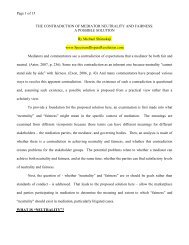

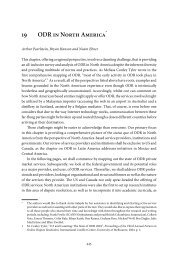
![Settlement Agreement Form [Agreement] - Mediate.com](https://img.yumpu.com/50682143/1/190x245/settlement-agreement-form-agreement-mediatecom.jpg?quality=85)

